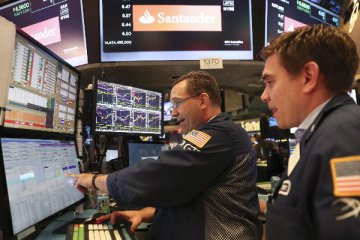In the week ending Nov. 29, the Dow climbed 0.63 percent, the S&P 500 gained 0.99 percent and the Nasdaq advanced 1.70 percent.
Wall Street wrapped up Friday on a downbeat note with the three major indexes falling, as investors observed the market on Black Friday, the start of the latest U.S. holiday shopping season.
The Dow Jones Industrial Average fell 112.59 points, or 0.40 percent, to 28,051.41. The S&P 500 was down 12.65 points, or 0.40 percent, to 3,140.98. The Nasdaq Composite Index decreased 39.70 points, or 0.46 percent, to 8,665.47.
Despite Friday's losses, the major averages notched monthly gains. The S&P 500 posted its biggest one-month gain of 3.4 percent since June.
The Dow and Nasdaq Composite won 3.7 percent and 4.5 percent respectively, marking their best monthly performance since June.
Online shopping sales on Black Friday were on track to reach 7.4 billion U.S. dollars, CNBC quoted data from Adobe Analytics as saying on Friday.
Shoppers spent 4.2 billion dollars online on Thanksgiving Day, or Thursday, an upswing of 14.5 percent year over year and hitting a record high, according to Adobe.
The three benchmark indexes hit fresh record highs on Wednesday, posting a three-day winning streak, after they reached all-time closing highs on the previous day.
On Wednesday, the Dow Jones Industrial Average increased 42.32 points, or 0.15 percent, to 28,164.00. The S&P 500 rose 13.11 points, or 0.42 percent, to 3,153.63. The Nasdaq Composite Index increased 57.24 points, or 0.66 percent, to 8,705.18.
Wall Street cheered the moderately higher U.S. growth rate in the third quarter (Q3) and were also encouraged by Jerome Powell's latest speech.
The U.S. gross domestic product (GDP) grew at an annual rate of 2.1 percent in Q3, higher than the first estimate of 1.9 percent, the Commerce Department said on Wednesday.
The reading, higher than the 2.0 percent rate in Q2, was mainly driven by upward revisions to private inventory investment, nonresidential fixed investment, and personal consumption expenditures.
Fed chairman Jerome Powell said on Monday evening that the U.S. monetary policy is now "well positioned" to support a robust labor market and "return inflation decisively" to the Fed's 2 percent target.
"At this point in the long expansion, I see the glass as much more than half full. With the right policies, we can fill it further," he said at the Greater Providence Chamber of Commerce.
On the data front, U.S. initial jobless claims fell sharply last week, pointing to the resilience of the labor market.
The number of people who applied for unemployment benefits dropped by 15,000 to 213,000 in the week ended Nov. 23, the Department of Labor said Wednesday.
New orders for manufactured durable goods in October increased 0.6 percent to 248.7 billion U.S. dollars, the U.S. Census Bureau reported on Wednesday.
This increase, up four of the last five months, followed a 1.4 percent decrease in September, according to the Bureau.
The Conference Board's consumer confidence index fell to 125.5 in November, marking a four-month losing streak, the think tank reported on Tuesday.
"Consumer confidence declined for a fourth consecutive month, driven by a softening in consumers' assessment of current business and employment conditions," said Lynn Franco, senior director of economic indicators at The Conference Board.
Sales of new single-family houses registered an annual rate of 733,000 in October, down 0.7 percent from the revised September rate, the U.S. Census Bureau said on Tuesday.
The median sales price of new houses sold last month was 316,700 U.S. dollars, lower than the average sales price.




















Latest comments